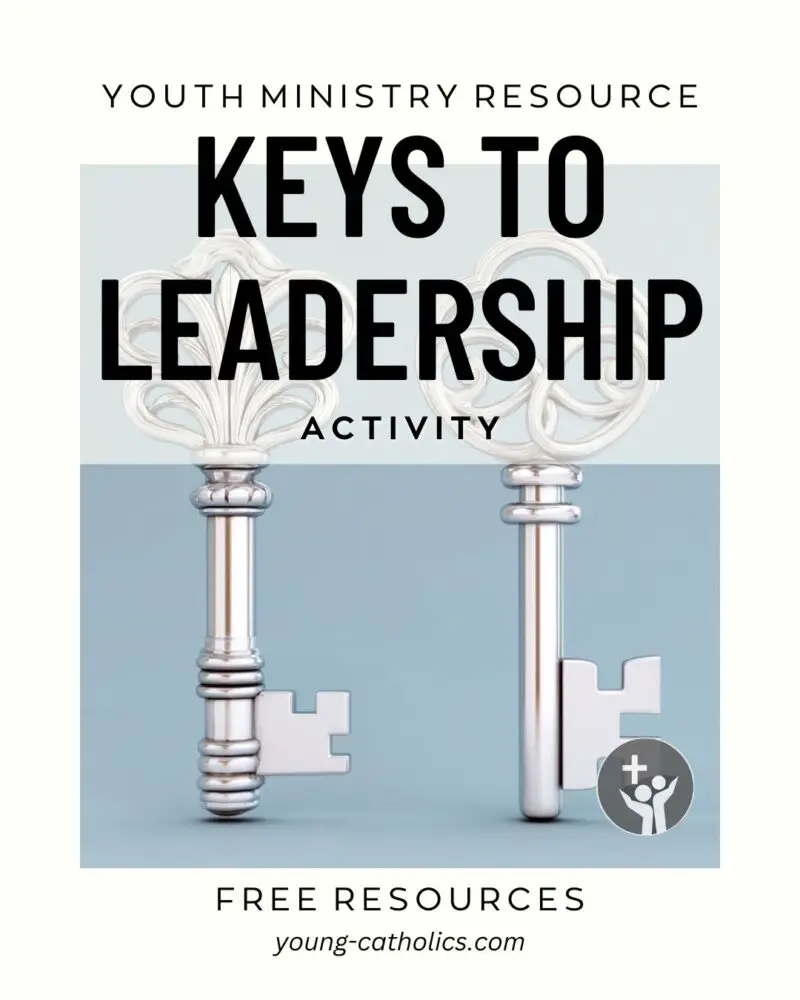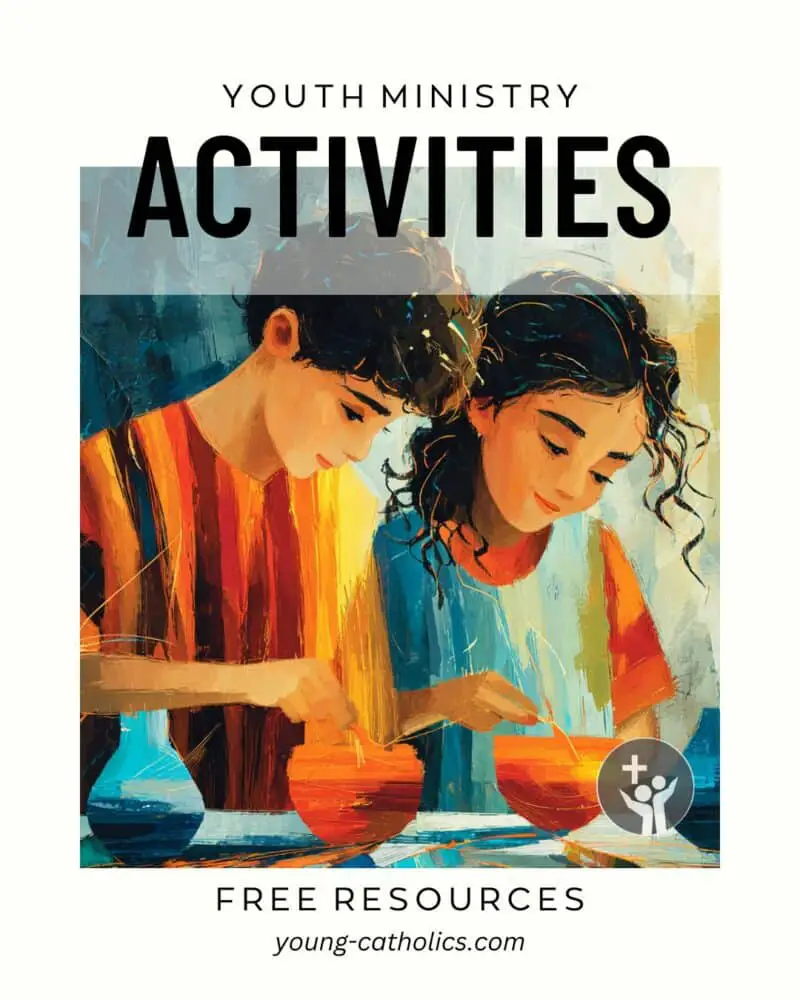Keys to Leadership Activity

Leadership is a gift that grows when young people are given the chance to practice it. The Keys to Leadership activity helps youth step into real situations where choices matter. Instead of just talking about leadership, they experience it. They learn how their words, actions, and decisions can shape a group and influence others. This hands-on approach makes the lessons more memorable.
Young people often wonder if their voice really matters. This activity shows them that it does. By working together, they see how different ideas can lead to stronger outcomes. They discover that good leadership is not about control, but about listening, guiding, and finding common ground. These lessons can carry into school, family, church, and beyond.
Faith plays an important part in leadership. Just as Peter was given responsibility after declaring his faith in Jesus, youth can see how faith gives direction to their choices. Leadership grounded in faith is not about seeking power. It is about service, humility, and care for others. The activity opens the door to seeing leadership as a way of living out their belief in Christ.
In the end, the Keys to Leadership activity is not only about skills. It is about forming character. It helps youth see themselves as leaders in daily life, no matter how small the setting. When they connect their faith with their decisions, they become leaders who can build up the Church and the world around them.
Building on the Rock of Faith
This activity ties closely to the story of Peter in Matthew 16. Peter’s faith in Jesus became the rock on which the Church was built. In the same way, youth are invited to see how their own choices and faith can build up their communities. By practicing leadership, they learn that strong foundations come from trust in God and the courage to follow His call.
Catholic catechesis often teaches that leadership is service. Jesus showed this when He washed the feet of His disciples. The scenarios in this activity help youth see leadership as more than making decisions. It is about caring for others, seeking the common good, and putting faith into action. This connects the lessons of the Gospel to real life.
For youth ministry, the activity creates a space where faith and life meet. It gives young people a safe way to practice skills they will use in school, parish, and future work. It shows them that Catholic teaching is not only about learning doctrine but about living it out. This makes faith active, engaging, and connected to their everyday choices.
Keys to Leadership Instructions
Materials Needed
- Bibles or printed copies of Matthew 16:13-20
- Paper, pens, or pencils
- Whiteboard, chalkboard, or large sheets of paper
- Markers or chalk
- Chairs arranged for group discussion
Directions
- Begin by reading Matthew 16:13-20 aloud.
- Divide participants into small groups. Try to mix different ages and personalities.
- Give each group a scenario about a leadership challenge. You may choose from the list provided or create your own.
- Provide paper or a whiteboard for each group to take notes and brainstorm ideas.
- Ask groups to discuss their scenario. Encourage them to listen carefully, share ideas, and work toward a decision together.
- After group time, gather everyone back together.
- Have each group share the main points of their discussion and their final decision.
- As a large group, talk about what was learned. Connect the discussion back to Peter’s role as a leader in the scripture passage.
- Emphasize how faith, listening, and humility are part of leadership.
Additional Notes
- If the group is small, do the activity together instead of dividing into groups.
- Keep the scenarios age-appropriate and relevant to the youth’s own experiences.
- Encourage respect for all voices in the group. Remind participants to take turns and avoid talking over others.
- For safety, be mindful of physical activities if included in a scenario. Make sure the setting is safe and supervised.
- To add variety, you can let groups act out their solutions as a short skit instead of just reporting back.
Scenario Examples
These are just examples. Feel free to use relevant examples related to what is happening in your community.
- Team Building Dilemma: The youth group is planning a team-building event. Some members want a physical challenge, while others prefer a creative workshop. The decision could affect team cohesion and engagement.
- Social Justice Initiative: The group is passionate about addressing a social issue. They must decide between organizing a peaceful protest or a community awareness campaign. This scenario delves into ethical decision-making and community impact.
- Music Selection: The youth group is responsible for selecting the music for Mass. They must choose between a traditional format and a contemporary approach. This scenario explores the balance between preserving tradition and embracing innovation.
- Charity Allocation Challenge: The group has raised funds for charity and must decide which organization to support. Each charity serves a different cause, prompting participants to weigh the impact of their choice on different communities.
- Youth Leadership Retreat: The group is tasked with planning a leadership retreat for their peers. They must decide between a local retreat focusing on skill-building and a larger regional retreat centered on networking and inspiration.
- Virtual Event Innovation: The group wants to organize a virtual event. They need to choose between a traditional webinar-style event and an interactive virtual game night. This scenario navigates the challenges of engaging an online audience.
- Eco-Friendly Initiative: The group is enthusiastic about launching an eco-friendly initiative. They need to choose between implementing recycling programs or promoting sustainable practices. This scenario touches on responsible decision-making for the environment.
- Community Service Focus: The group aims to engage in community service. They must decide whether to focus on local needs, such as food drives, or broader issues, like international disaster relief. This scenario explores balancing local impact with global concerns.
- Youth Group Leadership Structure: The youth group is restructuring its leadership roles. They need to decide between a hierarchical structure and a more collaborative approach. This scenario delves into leadership styles and group dynamics.
- Spiritual Retreat Theme: The group is planning a spiritual retreat. They must choose between a theme of self-discovery and reflection or a theme of community and togetherness. This scenario delves into the deeper purpose of spiritual gatherings.
Leading with Faith Lesson
Lesson Plan for Grades 6-8
Supplies
- Bibles or copies of Matthew 16:13-20
- Paper and pencils
- Whiteboard or large paper
- Markers
- Chairs for small groups
Timeline
5 minutes – Opening prayer and scripture reading
10 minutes – Introduction to leadership and Peter’s story
20 minutes – Group activity with scenarios
15 minutes – Sharing and discussion
10 minutes – Reflection and closing prayer
Lesson Steps
- Begin with a short prayer asking God to guide the group in learning about leadership.
- Read Matthew 16:13-20 together. Ask the children what stands out to them in the reading.
- Explain that Peter was given a special role of leadership because of his faith. Tell them that today they will practice leadership in their own way.
- Divide into small groups. Give each group a scenario about a leadership challenge. Provide paper and markers for notes.
- Let each group talk about their scenario. Encourage listening, respect, and teamwork.
- Bring the groups back together. Have each group share what they decided and how they worked together.
- Lead a short discussion. Ask questions such as: What was hard? What was easy? How did you listen to each other? How did you make choices that help everyone?
- Connect their answers back to Peter. Explain that like Peter, their faith can guide their choices.
- End with a short reflection. Invite each child to think of one way they can be a leader at home, school, or church.
- Close with prayer, thanking God for the gift of leadership and asking for courage to use it well.
This lesson can be used in religious education, children’s liturgy of the word, youth ministry, VBS, or other settings. It works because it is active, simple, and rooted in scripture.
Resources

More Youth Ministry Activities
If you are looking for more ways to engage young people in faith, our youth ministry activities page has many ideas to explore. You will find activities that help youth grow in prayer, friendship, and service. These activities are designed to be simple, meaningful, and fun. They give leaders and teachers tools to make faith real in the lives of children and teens.
Our youth ministry activities page includes games, prayers, and lessons that can be used in many settings. Whether you are planning for a parish group, a classroom, or a retreat, there are options to fit your needs. Each idea helps youth see how their faith connects to daily life. Visit the page to find more resources that can strengthen your ministry and inspire your group.
Social Media Graphics and Bulletin Artwork
Keys to Leadership

This beautiful image of keys is a perfect companion to the Keys to Leadership activity. It can be used in parish bulletins, newsletters, or lesson materials to highlight themes of faith and responsibility. Download and share it with your community as a reminder that true leadership begins with faith in Christ and service to others.
This resource is a simple way to bring scripture to life and inspire reflection. Add it to your materials today and use it to encourage youth and adults alike to grow as leaders of faith.
Paid subscribers may download a large copy this digital artwork without watermarks, suitable for use in bulletins, social media, newsletters, etc., free of charge by clicking here. You must be logged in as a paid subscriber to access the file.
Only current paid subscribers have the rights to use the artwork.
Questions and Answers for the Keys to Leadership Activity
What age group is this activity for?
This activity works best for middle school and high school students. It is written for grades 6–12, but you can adjust it for younger or older groups.
How much time does the activity take?
It usually takes about 45–60 minutes. You can shorten or extend it depending on the time you have.
Do I need special supplies?
No special supplies are needed. Just Bibles, paper, pens, and something to write on like a whiteboard or poster paper.
Can I do this with a small group?
Yes. If you have a small group, just do the scenarios together as one group instead of dividing.
How does this connect to faith?
The activity begins with Peter’s story in Matthew 16. It shows how faith is a guide for leadership and decision-making.
Can this be used outside of youth ministry?
Yes. It can also be used in classrooms, retreats, Vacation Bible School, or family faith nights.
Keys to Leadership
The Keys to Leadership activity gives youth the chance to step into leadership in a safe and meaningful way. It begins with Peter’s bold confession of faith in Matthew 16, where Jesus entrusts him with the keys to the kingdom. This story shows how faith and leadership are connected, and the activity builds on that truth.
Youth work through real-life scenarios about group decision-making. They are asked to listen, share, and guide their group toward choices that reflect service and care. These discussions help them see that leadership is not about control but about responsibility and teamwork.
The activity also connects leadership to faith. Just as Peter’s trust in Jesus guided him, youth are encouraged to let their faith guide their choices. This lesson shows that leadership rooted in faith builds stronger communities. It helps youth see themselves as leaders in church, school, and family life.
Your Turn
The Keys to Leadership activity is a simple way to help youth grow in both faith and leadership. It connects scripture to everyday life and shows young people that their choices matter. It gives them practice in listening, sharing, and guiding others with respect.
Try this activity with your group and see how they respond. Every group is different, so you may want to adjust the scenarios or add your own. Share your ideas and experiences in the comment section. Your notes may inspire other leaders and give them fresh ways to bring this activity to life.



Leave a Reply